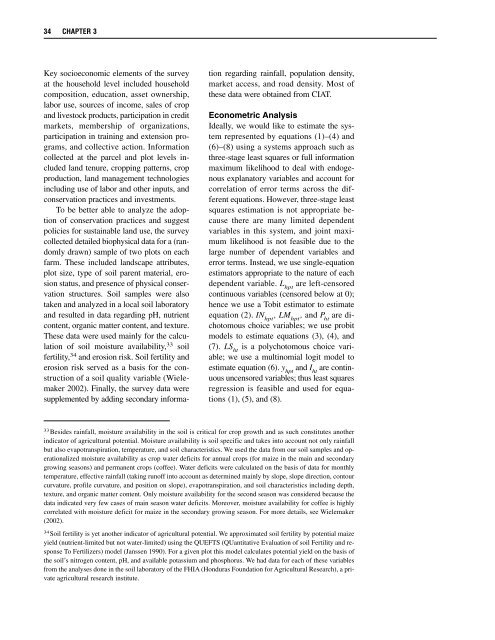Rural Development Policies and Sustainable Land Use in the ...
Rural Development Policies and Sustainable Land Use in the ...
Rural Development Policies and Sustainable Land Use in the ...
You also want an ePaper? Increase the reach of your titles
YUMPU automatically turns print PDFs into web optimized ePapers that Google loves.
34 CHAPTER 3<br />
Key socioeconomic elements of <strong>the</strong> survey<br />
at <strong>the</strong> household level <strong>in</strong>cluded household<br />
composition, education, asset ownership,<br />
labor use, sources of <strong>in</strong>come, sales of crop<br />
<strong>and</strong> livestock products, participation <strong>in</strong> credit<br />
markets, membership of organizations,<br />
participation <strong>in</strong> tra<strong>in</strong><strong>in</strong>g <strong>and</strong> extension programs,<br />
<strong>and</strong> collective action. Information<br />
collected at <strong>the</strong> parcel <strong>and</strong> plot levels <strong>in</strong>cluded<br />
l<strong>and</strong> tenure, cropp<strong>in</strong>g patterns, crop<br />
production, l<strong>and</strong> management technologies<br />
<strong>in</strong>clud<strong>in</strong>g use of labor <strong>and</strong> o<strong>the</strong>r <strong>in</strong>puts, <strong>and</strong><br />
conservation practices <strong>and</strong> <strong>in</strong>vestments.<br />
To be better able to analyze <strong>the</strong> adoption<br />
of conservation practices <strong>and</strong> suggest<br />
policies for susta<strong>in</strong>able l<strong>and</strong> use, <strong>the</strong> survey<br />
collected detailed biophysical data for a (r<strong>and</strong>omly<br />
drawn) sample of two plots on each<br />
farm. These <strong>in</strong>cluded l<strong>and</strong>scape attributes,<br />
plot size, type of soil parent material, erosion<br />
status, <strong>and</strong> presence of physical conservation<br />
structures. Soil samples were also<br />
taken <strong>and</strong> analyzed <strong>in</strong> a local soil laboratory<br />
<strong>and</strong> resulted <strong>in</strong> data regard<strong>in</strong>g pH, nutrient<br />
content, organic matter content, <strong>and</strong> texture.<br />
These data were used ma<strong>in</strong>ly for <strong>the</strong> calculation<br />
of soil moisture availability, 33 soil<br />
fertility, 34 <strong>and</strong> erosion risk. Soil fertility <strong>and</strong><br />
erosion risk served as a basis for <strong>the</strong> construction<br />
of a soil quality variable (Wielemaker<br />
2002). F<strong>in</strong>ally, <strong>the</strong> survey data were<br />
supplemented by add<strong>in</strong>g secondary <strong>in</strong>formation<br />
regard<strong>in</strong>g ra<strong>in</strong>fall, population density,<br />
market access, <strong>and</strong> road density. Most of<br />
<strong>the</strong>se data were obta<strong>in</strong>ed from CIAT.<br />
Econometric Analysis<br />
Ideally, we would like to estimate <strong>the</strong> system<br />
represented by equations (1)–(4) <strong>and</strong><br />
(6)–(8) us<strong>in</strong>g a systems approach such as<br />
three-stage least squares or full <strong>in</strong>formation<br />
maximum likelihood to deal with endogenous<br />
explanatory variables <strong>and</strong> account for<br />
correlation of error terms across <strong>the</strong> different<br />
equations. However, three-stage least<br />
squares estimation is not appropriate because<br />
<strong>the</strong>re are many limited dependent<br />
variables <strong>in</strong> this system, <strong>and</strong> jo<strong>in</strong>t maximum<br />
likelihood is not feasible due to <strong>the</strong><br />
large number of dependent variables <strong>and</strong><br />
error terms. Instead, we use s<strong>in</strong>gle-equation<br />
estimators appropriate to <strong>the</strong> nature of each<br />
dependent variable. L hpt<br />
are left-censored<br />
cont<strong>in</strong>uous variables (censored below at 0);<br />
hence we use a Tobit estimator to estimate<br />
equation (2). IN hpt<br />
, LM hpt<br />
, <strong>and</strong> P ht<br />
are dichotomous<br />
choice variables; we use probit<br />
models to estimate equations (3), (4), <strong>and</strong><br />
(7). LS ht<br />
is a polychotomous choice variable;<br />
we use a mult<strong>in</strong>omial logit model to<br />
estimate equation (6). y hpt<br />
<strong>and</strong> I ht<br />
are cont<strong>in</strong>uous<br />
uncensored variables; thus least squares<br />
regression is feasible <strong>and</strong> used for equations<br />
(1), (5), <strong>and</strong> (8).<br />
33<br />
Besides ra<strong>in</strong>fall, moisture availability <strong>in</strong> <strong>the</strong> soil is critical for crop growth <strong>and</strong> as such constitutes ano<strong>the</strong>r<br />
<strong>in</strong>dicator of agricultural potential. Moisture availability is soil specific <strong>and</strong> takes <strong>in</strong>to account not only ra<strong>in</strong>fall<br />
but also evapotranspiration, temperature, <strong>and</strong> soil characteristics. We used <strong>the</strong> data from our soil samples <strong>and</strong> operationalized<br />
moisture availability as crop water deficits for annual crops (for maize <strong>in</strong> <strong>the</strong> ma<strong>in</strong> <strong>and</strong> secondary<br />
grow<strong>in</strong>g seasons) <strong>and</strong> permanent crops (coffee). Water deficits were calculated on <strong>the</strong> basis of data for monthly<br />
temperature, effective ra<strong>in</strong>fall (tak<strong>in</strong>g runoff <strong>in</strong>to account as determ<strong>in</strong>ed ma<strong>in</strong>ly by slope, slope direction, contour<br />
curvature, profile curvature, <strong>and</strong> position on slope), evapotranspiration, <strong>and</strong> soil characteristics <strong>in</strong>clud<strong>in</strong>g depth,<br />
texture, <strong>and</strong> organic matter content. Only moisture availability for <strong>the</strong> second season was considered because <strong>the</strong><br />
data <strong>in</strong>dicated very few cases of ma<strong>in</strong> season water deficits. Moreover, moisture availability for coffee is highly<br />
correlated with moisture deficit for maize <strong>in</strong> <strong>the</strong> secondary grow<strong>in</strong>g season. For more details, see Wielemaker<br />
(2002).<br />
34<br />
Soil fertility is yet ano<strong>the</strong>r <strong>in</strong>dicator of agricultural potential. We approximated soil fertility by potential maize<br />
yield (nutrient-limited but not water-limited) us<strong>in</strong>g <strong>the</strong> QUEFTS (QUantitative Evaluation of soil Fertility <strong>and</strong> response<br />
To Fertilizers) model (Janssen 1990). For a given plot this model calculates potential yield on <strong>the</strong> basis of<br />
<strong>the</strong> soil’s nitrogen content, pH, <strong>and</strong> available potassium <strong>and</strong> phosphorus. We had data for each of <strong>the</strong>se variables<br />
from <strong>the</strong> analyses done <strong>in</strong> <strong>the</strong> soil laboratory of <strong>the</strong> FHIA (Honduras Foundation for Agricultural Research), a private<br />
agricultural research <strong>in</strong>stitute.
















